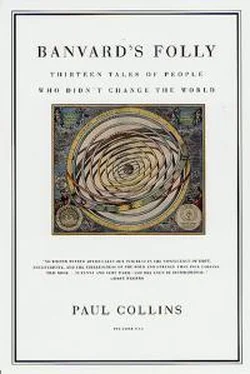rain, and neglect. They read, in part: John Cleves Symmes joined the Army of the U.s. as an ensign, in the year 1802. He afterwards performed daring feats of Bravery in the Battles of Lundy's Lane and Sortie from Fort Erie. Capt. John Cleves Symmes was a Philosopher, and the originator of the "Symmes Theory of Concentric Spheres and Polar Voids." He contended that the Earth was hollow and habitable within.
The monument, erected by Symmes's son in the 1840's, is surrounded by the sort of wrought-iron fencing typically found around old cemetery plots.
Nearby, on hot and dusty summer days, locals play on a basketball court. They utterly ignore the old obelisk in their midst--a more apt reflection of the life of the man buried beneath it, perhaps, than the monument itself ever was.
Symmes was indeed a brave man, although at first this bravery took a rather obvious physical form. Born in Sussex County, New Jersey, in 1780 and the namesake of a famous uncle who had developed the Northwest Territory, Symmes received a tolerable if brief common school education. He was literate, but hardly polished; he did, however, have a love of learning that often drew him to haunt public libraries. His scant schooling was not unusual for the time--other than clergy, lawyers, and doctors, few men in the late eighteenth century had the luxury of a formal college education.
In 1802 Symmes enlisted in the army. He first saw action on an open field--in a duel, that is, with a bullying fellow officer named Lieutenant Marshall. In moments Marshall was lying on the ground with a broken leg and Symmes was bleeding from a shot to his wrist. Symmes reported shortly afterward, "I wanted to know if he desired another shot, and being informed in the negative
... with my handkerchief wrapped around my wound, I went home and ate a hearty breakfast." He was no less fearless as a captain in the War of 1812. At the Battle of Bridgewater his company repelled three bayonet charges, and at Fort Erie he captured a British artillery position and destroyed its cannon.
Retiring as a war hero, Symmes took the well-worn career route of becoming a supplier to his old employer: he set up shop as a military provisioner and Indian trader in the upper Mississippi. He set aside some money and married a widow, and soon the two were living in St. Louis and presiding over a brood of ten children. He could have retired into the comfortable life of a respectable patriarch looking ahead to a lifetime of steady military business. But something was eating at John Cleves Symmes.
He had discovered that an entire world lay hidden beneath our feet--and only he knew how to find it.
Symmes spent his military retirement in contemplation, observing migratory patterns and perusing books on geology and maritime exploration in his local libraries. There is no telling how long the notion of a hollow earth had occupied his mind, but he had now become obsessed by it. Writing up a brief tract in unadorned prose, he trudged down to his local printer and ordered up enough copies to send to every college, municipal government, senator, and eminent scientist in the country--and then some more copies, to go to every major foreign university as well. Titled Circular Number 1--for indeed many more were to follow--the publication introduced Symmes to the world on April 10, 1818:
I declare that the earth is hollow and habitable within; containing a number of solid concentric spheres, one within the other, and that it is open at the poles twelve or sixteen degrees. I pledge my life in support of this truth, and am ready to explore the hollow, if the world will support and aid me in my undertaking.
I ask one hundred brave companions, well equipped, to start from Siberia, in the fall season, with reindeers and sleighs, on the ice of the frozen sea; I engage we find a warm and rich land, stocked with thrifty vegetables and animals, if not men, on reaching one degree northward of latitude 82; we will return in the succeeding spring.
With this, Symmes thoughtfully attached a certificate of his sanity.
The circular was not well received. He was rebuffed by scholars and eminent statesmen across the country, and the French Academy of Sciences tabled his paper as unworthy of consideration. In a crowning insult, the London Morning Chronicle doubted the provenance of Symmes's certificate of sanity.
The theory itself was a relatively simple one, even if Symmes was at times a little unclear on specifics. Concentric spheres were, Symmes pointed out, a most efficient arrangement of natural architecture. Bones, plant stems, trees, lava tubes, insect limbs--all showed the biodesign of hollow tubes or concentric structures.
Enquire of the botanist, and he will tell you that the plants which spring up spontaneously agreeable to the established laws of nature, are hollow cylinders .... Enquire of the anatomist, and he will tell you that the large bones of all animals are hollow ... even the minutest hairs of our heads are hollow. Go to the mineralist, and he will inform you that the stone called Aerolites, and many other mineral bodies, are composed of hollow concentric circles.
Symmes simply applied this principle of structure at a planetary level.
Andwiththe planet revolving, centrifugal force would fling material out along the axis, creating convenient holes at the poles through which intrepid souls like himself could venture into the inner world. Inside, Symmes believed, were multiple spheres, each accessible via a series of polar holes. Sunlight pouring through the holes and refracted through a dense interior atmosphere of
"aerial elastic fluid" suffused these inner worlds with light and heat sufficient to sustain life.
Symmes believed this theory could account for all sorts of phenomena--magnetic fluctuations, the mysterious migrations of geese, caribou, and herring, and even the ocean's currents, for like a gigantic Charbydis, the earth's seas poured into one pole and gushed out from the other. Moreover, recent expeditions beyond the Arctic Circle had found open water where many had expected only frozen tundra. That, Symmes said, was from the outrush of warmed air from the interior world. After crossing "the icy circle," explorers would find a liquid and perhaps even tepid sea all around the poles, thus making for easy sailing into the interior realms, or what Symmes dubbed "the mid-plane space."
As it turned out, Symmes was not the first person to propose a hollow earth theory, and this was seized upon by learned critics to discredit him. In his 1618 work Epitome astrononomiae Copernicanae, Johannes Kepler had pondered the notion of the earth and other planets being composed of concentric shells. As one reference book published by Abraham Rees in 1813, The Cyclopedia, put it:
"If this [Kepler's theory] be the case, it is possible that the ring of Saturn may be the fragment or remaining ruin of his former exterior shell, the rest of which is broken or fallen down upon the body of the planet."
The hollow earth theory continued to attract distinguished support after Kepler's death. In 1692, Edmund Halley, the astronomer of comet fame, was confounded by distinct sets of fluctuating magnetic data. His ingenious
solution was to theorize that three internal spheres within the planet, revolving at different rates, were causing these distinct sets of data to appear. Perhaps, he imagined, there existed a luminous atmosphere between these shells, giving off sufficient light and heat to sustain life. In a 1716
article he even suggested that the aurora borealis was caused by the escape of this gas.
Five years later, Cotton Mather cited Halley's theories in his book The Christian Philosopher, and by mid-century the Swiss mathematician Leonhard Euler, the court mathematician to Frederick the Great of Russia, also lent his support to Halley's theory. But in the intervening century little attention was paid to the notion, which in any case had never achieved any popular currency.
Читать дальше











